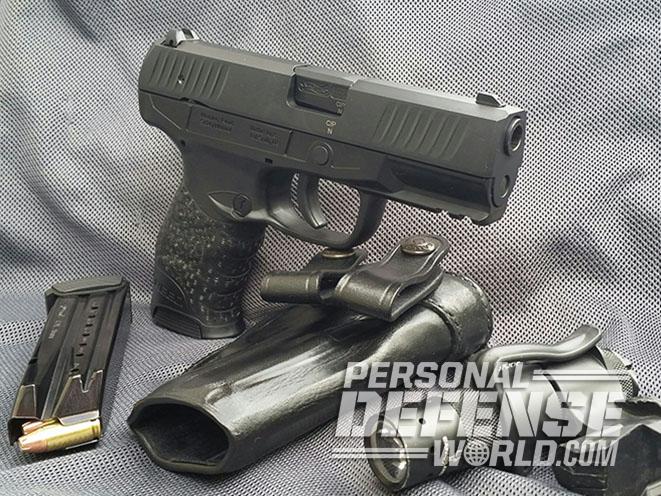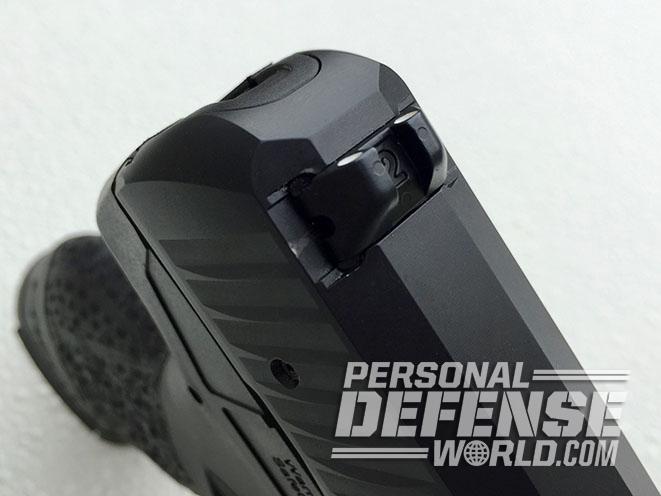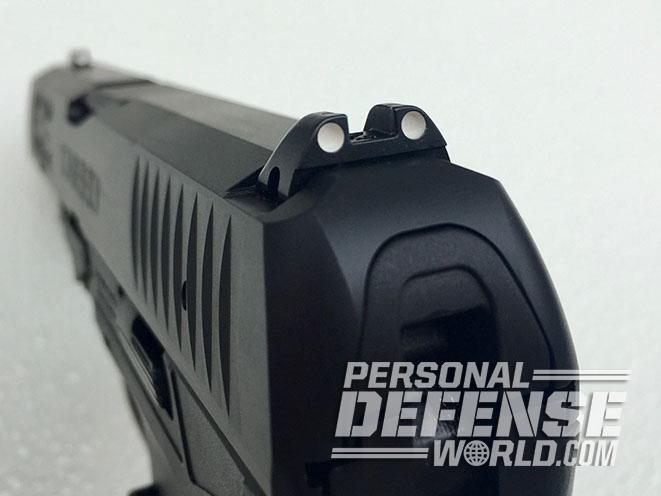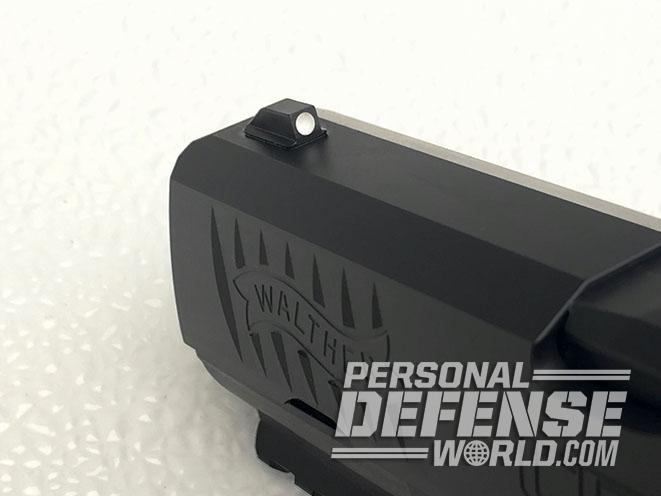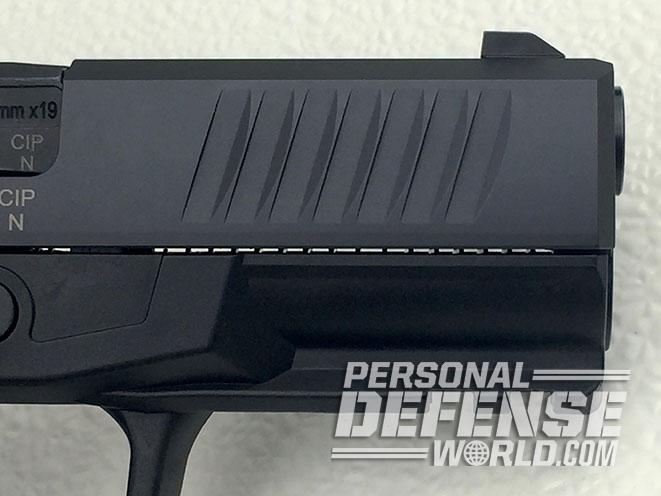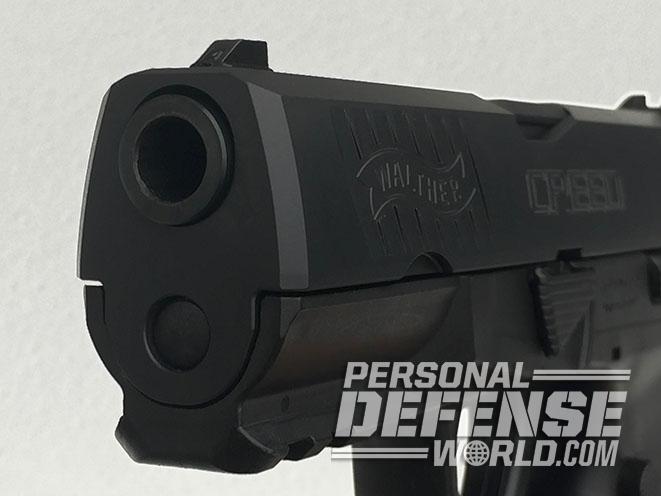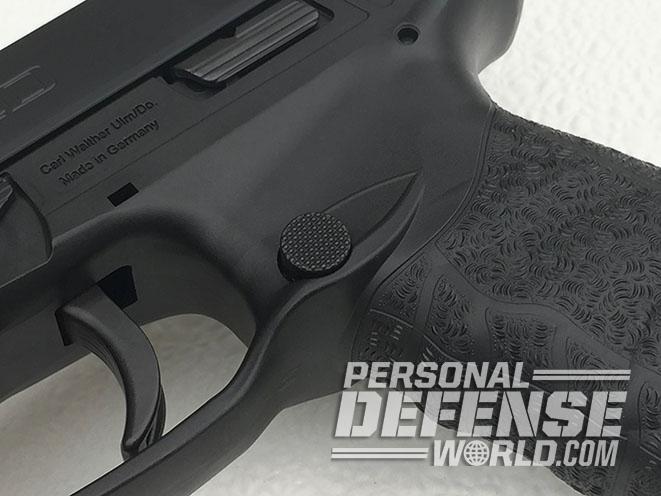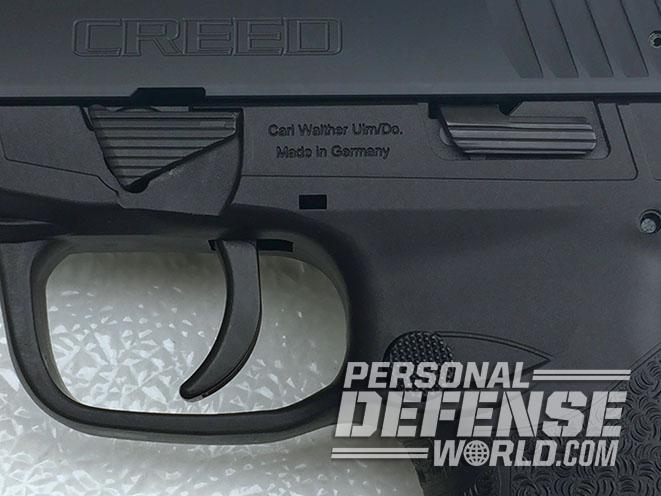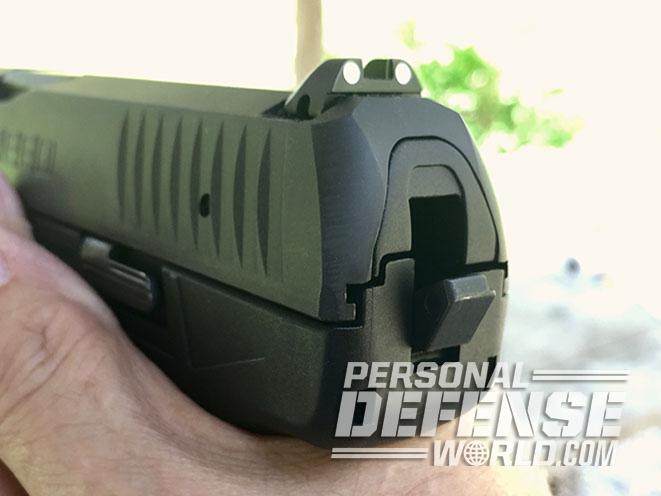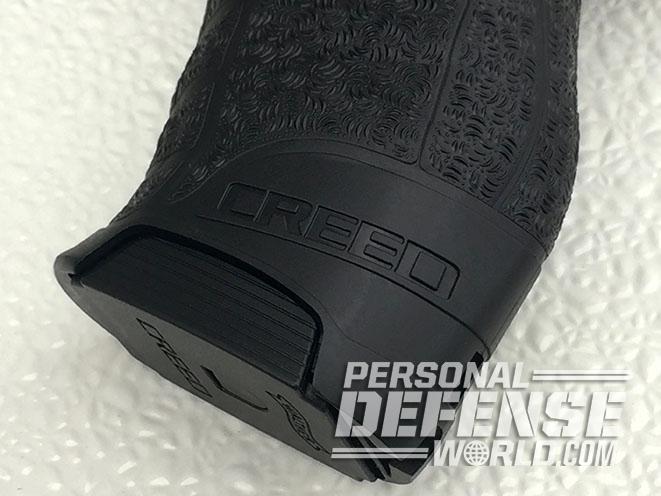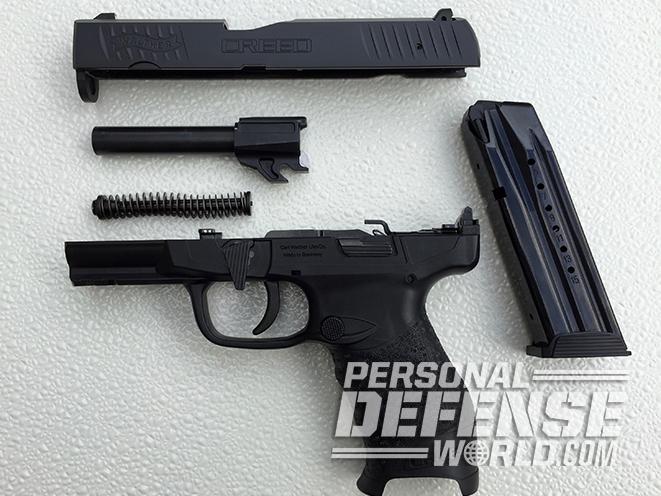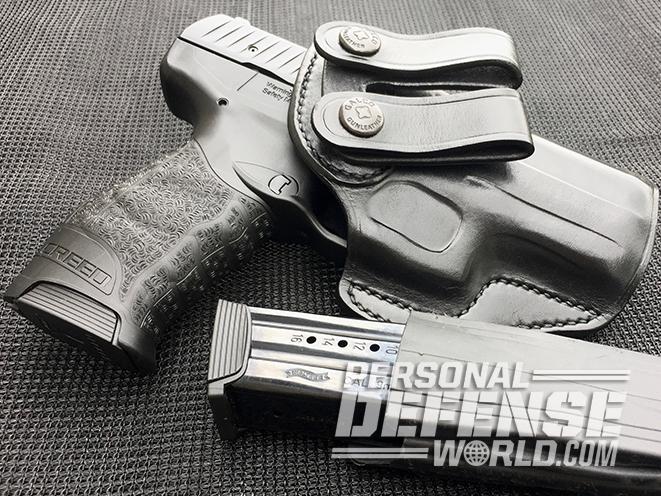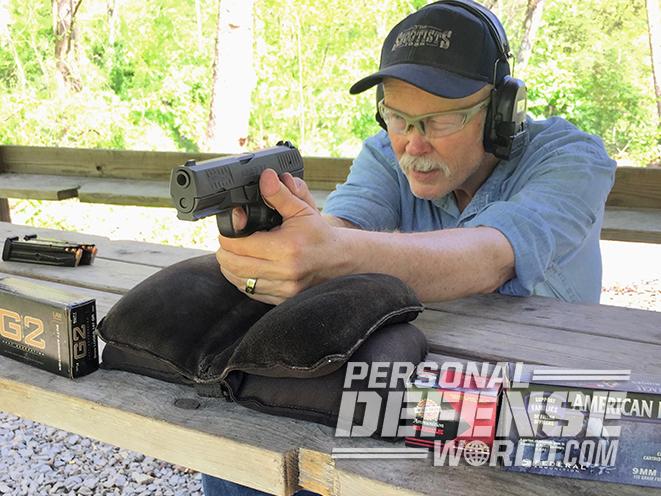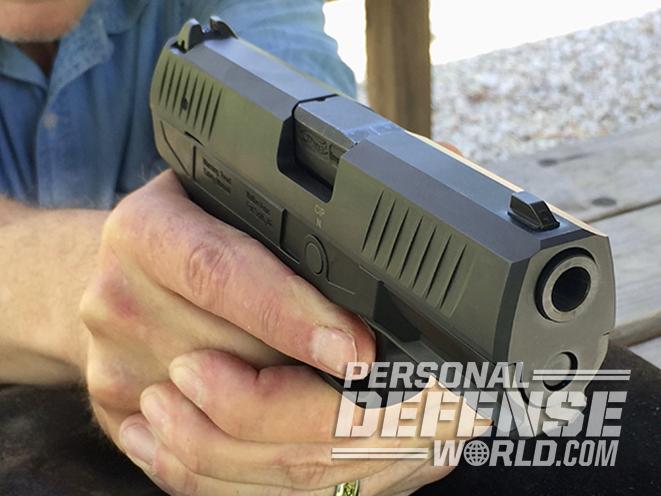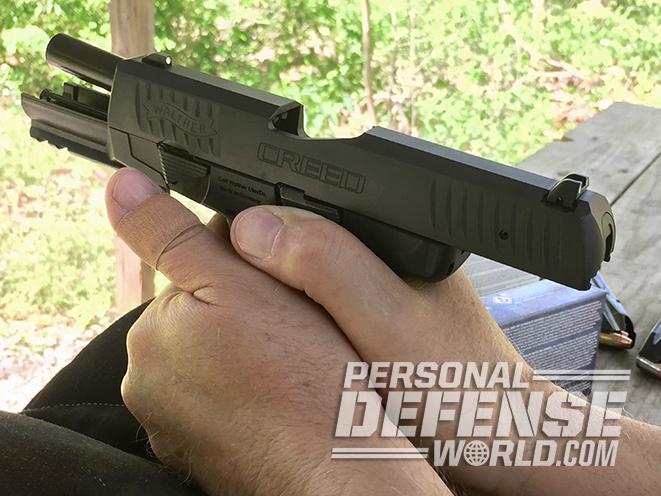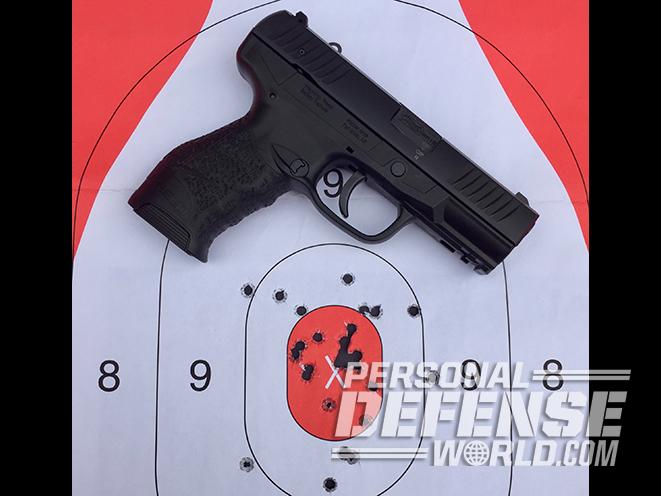I recently put out a preview post on social media about the new Walther Creed pistol. Unfortunately, it drew several uncomplimentary remarks, mostly associated with its appearance. Well, having spent some time with this handgun and taking it out for a range session, I would tell those critics that you can’t judge a book by its cover! I’m getting a little ahead of myself, so let’s backtrack a bit and discuss the Creed pistol in detail before we report on its performance.
First, the name. Walther usually doesn’t give monikers to its pistols. Most go by designations like PPK, TPH, P38, PPX, etc. However, the Creed is meant to bring more shooters into the Walther fold, joining the ranks of those following the Walther “creed,” hence the name. And I believe shooters will be lining up to buy this new Walther pistol.
A Closer Look

My test Walther Creed 9mm arrived in a black plastic carrying case with a foam rubber inner lining that held the gun, two extra magazines, the ubiquitous safety padlock, a firearms safety booklet and a very detailed and informative owner’s manual with color pictures.
Advertisement — Continue Reading Below
An examination of the exterior and innards of the test gun displayed the quality of fit and finish that I would expect from any Walther product at any price. And I’ll admit that it does have a somewhat radical appearance. The left side of the slide has a large “Walther” banner across the forward serrations, and about an inch back you’ll find “CREED” in big block letters. The portion of the barrel that is visible through the ejection port on the right side also has a small Walter banner and the 9mm marking.
- RELATED STORY: Amped Up PPS – Walther’s Compact PPS M2 Pistol
Overall, the pistol has a futuristic look like a Buck Rogers ray gun. The rugged, non-reflective finish on the steel parts is a matte black Tenifer, and the polymer one-piece grip frame is simply matte black.
The Walther Creed is a service-sized handgun with an unloaded weight of 27 ounces, an overall length of 7.3 inches and a 4-inch barrel. The barrel has conventional six-groove rifling in a 1-in-10-inch, right-hand twist rate. Of interest is the barrel’s three-piece construction. As a cost-cutting measure, the barrel is a round steel tube that’s rifled, then screwed into an investment-cast breech unit. The threads on the tube—cut in the opposite direction from the rifling—actually tighten the barrel while shooting. The breech unit serves as a locking block, with a camming surface on the bottom to unlock the breech, and on top there’s a small port that serves as a loaded-chamber indicator. The steel feed ramp is also a separate piece.
Advertisement — Continue Reading Below
The Walther Creed also has a captive recoil spring, and inside the polymer frame is a steel structure that contains the action and the rails on which the slide runs. The takedown process is super easy as well—no trigger pull is needed.
The height of the slide and the upper portion of the frame give this gun a somewhat “boxy” look, which lifts the height of the bore axis, but we’ll talk about that later. For a pistol at this price point ($399), it’s surprising to see steel sights set up in a three-white-dot pattern. A screw pins the front sight onto the frame, and it can be replaced by taller or shorter units. My test gun came with a #4 unit. The rear sight is held in a dovetail with a “tiger pin” and can be drifted right or left for windage.
The slide serrations are wide and squared, but rounded on the forward edges. These grooves make for good traction when it comes time to pull the slide, but they won’t catch on your holster or clothing while drawing the gun.
Advertisement — Continue Reading Below
The polymer frame, especially the grip portion, had me wondering when I first saw it because the backstrap has a pronounced “hump” that looked uncomfortable. However, in hand, this is a very ergonomic grip frame and fits my medium-sized hands to perfection. The dust cover features a two-slot accessory rail for lights or laser sights, and the frame also has a nice rounded triggerguard.

The takedown latch and slide stop catch on the left side of the frame are “melded” and shaped to prevent snagging. There’s also a generously sized magazine release button that’s checkered and protected from accidental activation by a shelf that runs back from the triggerguard on both sides.
The magazine release can easily be reversed, and pressing this button, the magazines pop out with aplomb. The grip portion of the frame has 360-degree texturing with subtle finger grooves and swells along the sides. The magazine well is hooked in front; it totally encloses the magazine base yet has cuts on each side in case you have to yank a magazine free. On the rear of the butt is a cutout area for a lanyard.
Advertisement — Continue Reading Below
MEC-GAR makes the blued steel 16-round magazines. They are easily disassembled without tools and have anti-tilt followers.
From top to bottom, this pistol is contoured to eliminate nearly all edges that could snag. Looking at the rear of the slide, you’ll see a spurless hammer. The Creed features a pre-cocked double-action trigger mechanism. Retracting the slide begins the cocking stroke, pulling the trigger brings back the hammer and, at its rear-most travel, releases the sear, allowing the hammer to fly forward, striking the firing pin. For safety, the smooth-faced trigger has about a half-inch of overtravel and then breaks cleanly at an average pull weight of 5.10 pounds. Unlike a true hammer-fired double-action-only (DAO) pistol, there is no second-strike capability with the Creed. Again, not to belabor this point, but for what you pay, I’d take this trigger on any of my autoloading pistols. As for manual safeties, there are none, plus there is no magazine disconnect. Like a double-action revolver, you are the safety. If you don’t want to shoot, don’t pull the trigger.
Walther Creed Test Ammo & Gear

The Walther Creed comes in the ever-popular 9mm cartridge. This round is making a strong comeback, having regained the acceptance of the FBI and many other law enforcement agencies, and it’s still a top choice of the military.
Advertisement — Continue Reading Below
To test the Creed, I selected 9mm cartridges that ran the gamut from 115-to 147-grain bullets. From Black Hills, I chose the 124-grain JHP +P load that appears to have an XTP-style bullet. From Federal, I chose the 115-grain American Eagle FMJ load, which came packed in a special blue box to support families of fallen law enforcement officers through COPS (Concerns Of Police Survivors). Then, from Speer, I picked the Gen 2 (G2) 147-grain Gold Dot load. The hollow cavity of this bullet is filled with an elastomer for rapid expansion when needed without overpenetration when it’s not.
Envisioning this pistol for concealed carry, I wanted a holster that would hide a full-sized gun, so I chose an inside-the-waistband (IWB) design. Galco’s Summer Comfort proved suitable. It’s made from smooth, black, premium steerhide with lock-stitched nylon threading. The holster is lightweight but has a metal reinforced mouth that helps keep its fitted shape while empty. It comes with detachable 1.75-inch belt loops so you can add or remove the holster without undoing your belt, and 1.25-inch loops are available.
This open-top holster has a forward cant and comes in right- and left-hand versions. It works best when carried just behind the hip in the 3 to 5-o’clock position.
Advertisement — Continue Reading Below
For packing an extra magazine, I chose the Safariland Model 71 belt pouch. It has a flexible plastic “accordion” design that accommodates many different pistol magazines. The integral belt loop fits 1.5- to 2.25-inch belts, and other versions are available, including an IWB model. It comes in black or Flat Dark Earth and is one of the most versatile items I own.
Going Downrange

I took the gun and accessories to the range on a beautiful day in late April. My first task was setting up my Oehler Model 35P chronograph to record velocities from the Creed’s 4-inch barrel. I then tested the pistol’s accuracy at 15 yards, as this is a DAO pistol with fixed sights.
I fired all three 9mm test cartridges from a bench using a sandbag as a rest. I shot three 5-shot groups with each load on regulation Bullseye targets. My point of aim was 6 o’clock of the X-ring at the center of the target, and my tightest cluster measured 1.65 inches using the hot Black Hills 124-grain JHP +P cartridges. This load also had the best overall group average. Second place went to the Speer ammo at only 2.43 inches. Only a couple of groups were wider than 3 inches, and none of the group averages was over 3 inches.
Advertisement — Continue Reading Below
- RELATED STORY: Gun Review – Walther PPQ 45
Practical shooting was next on the agenda with the Galco holster and Safariland magazine pouch. I had three 16-round magazines at my disposal, and I loaded with a mix of all three brands of 9mm test ammunition. I used the Creed to shoot my usual 30-round combat/qualification course, which begins from the holster at 3 yards. You draw and shoot six rounds with only your strong hand, reload, fire six rounds rounds with only your support hand, reload, assess the threat area and reholster.
Next, at 7 yards, you draw and fire three strings of double-taps using the sights, reload, assess for threats and reholster. Staying at 7 yards, I then drew and fired two shots center-mass and another to the head for a body armor drill. I repeated this, reloaded, assessed for posisble threats and reholstered.
Finally, at 15 yards, I shot twice while standing from the left side of a barricade, twice while standing from the barricade’s right side and then twice while kneeling on the same side. I used a B-27 silhouette target with scoring rings, and out of a possible 300 points, I scored 297 points with 16 bullseyes. I gave myself 10 points each for the two headshots. I also did some more combat-style shooting along with a couple drills involving five shots in five seconds at 5, 7 and 10 yards using 8-inch circular targets. All told, my son/photographer, Jordan, and I fired 185 rounds through the Walther Creed.
Advertisement — Continue Reading Below
The Price Is Right

What did we learn? The sights were “on” for me, and the point of aim/point of impact was very good. The Walther Creed’s grip ergonomics and streamlined design negated the rather high bore axis, and I had no issues with recoil or muzzle flip. The gun’s grip angle, balance and ergonomics also made for outstanding “pointability.” On the B-27 target, I fired my first 12 shots without the sights, and they all went into the 10 and X rings, plus I had only one miss on the five-second drill targets.
The Walther was easy to get on target for follow-up shots. The sights were easy to see with plenty of light showing on either side of the front sight. Reloading was effortless; empty magazines flew out of the magazine well when needed. I like how the slide released easily with the catch, even with an empty magazine in place. The Galco holster and Safariland magazine pouch worked very well, too. In short, I have no negative comments, and this Walther Creed is one heckuva bargain.
I don’t say this very often, but I’d definitely “ride the river” with this affordable pistol.
Caliber 9mm
Barrel 4 inches
OA Length 7.3 inches
Weight 27 ounces (empty)
Grip Polymer
Sights Three-dot
Action DAO
Finish Matte black
Capacity 16+1
MSRP $399
